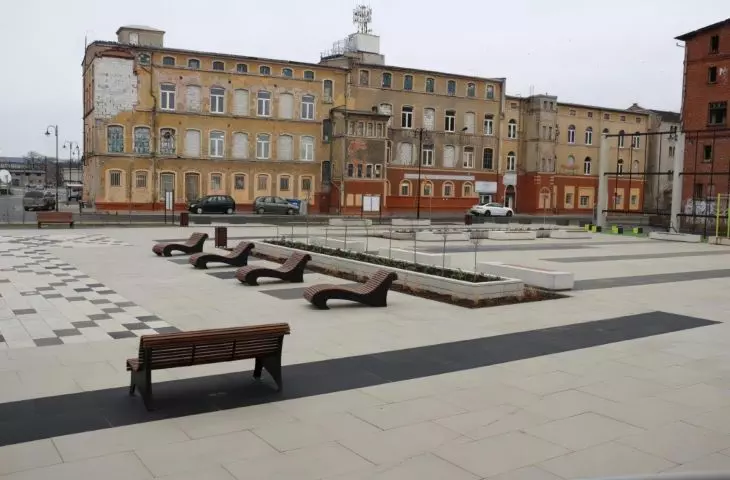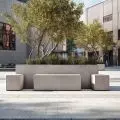I read revitalization, I think concrete square
Have you ever wondered how it is possible that although revitalization in our country wipes its mouth with the philosophy of sustainable development at every turn and is in its nature obliged to play by its rules, nevertheless, when it comes toto create or renovate some important public space, it almost always turns out that the environmental component of this process has not been invited to this ceremonial party, or is there as a spectator in the last stand behind a pillar?
That is why today I decided to take you to one such place. To tell you the truth, I didn't take special pains to find a suitable example to illustrate this despair and misery. I reached for the first example that came across my eyes, being almost 100 percent sure that I would come across something suitably unpleasant anyway. That's why I invite you to New Sol, where, as part of the ongoing revitalization program, a moderate tragedy has been performed, so far, with the prospect of continuing this honorable work.
However, I would like to avoid this time a situation where we will look at another ugly place, complain, spitting bitterness in the style of "And this is Poland," "Teddy bear to the best of our ability," or "I wonder who mademade money on it," only to scroll down five minutes later to forget about the topic and gleefully collide with another such revitalization in a week, a month, in six months. That's why I won't let it go this time. We have a corpse on the table and will dissect this revitalization program. However, in order not to grind late into the night with the entire 160-plus page document, I have decided to focus for you on a selected issue that is conspicuous by its faults, namely the environmental aspect and how, step by step, it translated in this case into this honorable concrete square effect.
Revitalization of the Odra plant in Nowa Sol
© Jacek Milewski Mayor of the City of Nowa Sól
I think that tracing this disaster can be quite interesting and informative, and give us some insight into the standard mechanism of castrating revitalization from the principles of sustainability. First, however, a reminder of simple things. What is sustainable development? Well, it is best to use a metaphor. Sustainability, ladies and gentlemen, is a kind of stool. A stool equipped with three legs. Three points of support to ensure its stability, if we feel like sitting on it our revitalization and not getting a bump. Social, Economic and Environmental Spheres. If we skip any of these, the stool topples over. So, already armed with this simple and seemingly obvious knowledge, we move on.
So how does it present itself in New Sol? Already cursorily reviewing the program itself, I noticed that out of more than one hundred and sixty pages (which is neither a lot nor had for this type of program), a total of only two pages would have accumulatedof real content concerning the environment, not counting the waving of the word for cheer here and there without any real context in the form of striking substance to which it would refer. I know, it doesn't sound good, but let's give New Sol a chance. Maybe it's a very tightly focused piece full of brilliant conclusions and recommendations.
Revitalization of the Odra plant in Nowa Sól
© Jacek Milewski Mayor of the City of Nowa Sól
Let me say right away that it starts very nicely—with a description of the state of the environment, where in one sentence it actually says that the environment plays a very important role for the residents of Nowa Sól, only to point out at the same time that the share of wooded areas in the city is relatively low, at 13 percent. Well, and here one could say to oneself that OK, this is some kind of premise that tells us that the environment is important, but we have few trees and perhaps more would be useful. Admittedly, we already know how it is, because we can see pictures of this revitalization, but still, please keep this in mind, because we will be coming back to it. Later in the revitalization program we have a description of the state of this environment, and here, too, interesting things happen. We learn from it, for example, that the state of the environment in terms of water, soils and land is "acceptable," and in order to maintain this we need to equip new developments with sewers. OK. Admittedly, this is a revolutionary thesis on the scale of the revitalization carried out in the second century AD, but it's better to chuckle and write than not to write and forget. Admittedly, nothing was mentioned about micro-retention and more modern ways of managing water, but rest assured. This is just a description of the current state. Maybe there will be something later.
The second environmental threat is low emissions. Nothing surprises us here, of course, because how could it be otherwise. We live in Poland, the action takes place in the Recovered Territories, we have stoves left over from the Germans, and they burn whatever they can, and—as we all know—inhalation from a burning old piece of furniture covered with a centimeter-thick layer of varnish is not good for our respiratory tract.
The third threat to the quality of the environment is traffic noise, and here I will quote this grandeur in full, for a full understanding of the problem:
Another threat to the environment in cities in Lubuskie Province, including Nowa Sol, is pollution and noise associated with automobile and rail transportation. Given the intensive development of communications and the increase in motor vehicle traffic, it can be assumed that noise emissions will increase.
Cheers, applause. I'll already skip the reference in this sentence to the area of the entire province, in order to dilute responsibility for this condition, but to write something like this in a revitalization program is a bit like going to theOlympics and just before performing in the competition to declare to reporters that "Well, you know, admittedly, we will take part and play what we play, but we expect to lose in advance, so don't count on too much."
With such an approach, it is indeed not going to win too much. But the good news, ladies and gentlemen, is that whether traffic and the noise that goes with it will increase doesn't really depend on the incomprehensible conjunction of planets, the verdicts of the god Svarog, or the lich that sits in the woods, but on what we do precisely as part of, say, eeee... revitalization, I guess? "Spoiler alert" the introduction of tall greenery in a city that itself claims to have relatively little of it could help a lot, both in terms of low emissions, because it has the ability to clean the air of particulate matter, as well ason noise issues, because it does a great job not only of screening, but also of absorbing sound in dense buildings, where noise otherwise bounces off the walls like a concert hall.
Well. We've got the description of the existing state behind us, so it's time for a fat and juicy diagnosis of the state of the environment. Here it is:
Diagnosis of the state of the environment in Nowa Sol
© Local Revitalization Program of the City of Nowa Sól
Yes, that's it. These few lines of text and a map are it. I don't know what the point is and how one follows from the other, but what do you think, how do you feel about it? So what? We already know everything? Well, then we can proceed to work, yes?
superbly objective juxtaposition in the revitalization program of the state of the environment with other problems of the site of the former Odra plant
© Pawel Mrozek
That's how one parameter taken out of context was studied, from which the conclusion was drawn that actually everyone has quite the same, but we don't know if it's bad or good, because we haven't compared it with anything objective. And so then, already as a completely stripped-down parameter (on an insanely stretched three-tier scale), we tabulate this against other issues, and for the example area of the Oder factory along with aa section of the downtown area, it comes out that greenery is not really an issue here, despite the fact that the industrial plant area itself is, in terms of environment and nature, a total desert and the most degraded area in the city. Anyway, when evaluating the other factors, including economic and social, it's clear that the municipality is doing an accurate diagnosis and pointing out real problems, so it's not like this whole revitalization program is a crock. The work has been done here, only one can't help feeling that everything has been put through some kind of green light elimination filter, where with each successive iteration and squeezing of this fine material through successive sieves and filters of the process, instead of getting an increasingly precise concentrate, we are struggling to squeeze out a few drops of water.
trying to base revitalization on only two of the three pillars of sustainability does not yield stable results
© Pawel Mrozek
With such an approach, it's no wonder that in further in-depth studies for the post-Odra plant site, whose revitalization is the magistrate's dream gem of the whole process, environmental issues never appear for anything more than generalities without indicating specific actions and locating problems geographically. The most emphatic formulation, by the way, is found there in the part where the residents themselves were able to make their voices heard, namely in the form of threats in the SWOT analysis. The uncomfortable statement "Devastation of park spaces, squares and neglect of green areas" appears there. But already in the specific questions, which were intended to help objectively give individual problems the appropriate weighting regarding the area, the city asked residents questions on 41 issues, only one of which concerned an overall assessment of environmental pollution, and it came out badly, however, getting lost in the entire pool of negative assessments of the other 40 factors and criteria. I don't think I need to explain that surveys formulated in this way, backed by a previously flawed diagnosis, are the perfect machine for eliminating the environmental issue in the revitalization process. In this context, the result in the form of concrete hectares devoid of greenery is not surprising. The designer, deriving the rationale from the revitalization program, basically had no chance to enrich the project with comments on greenery, because they simply aren't there, and if he even included the premise of environmental pollution, it one gets the impression that he and the city authorities have come to the conclusion that a clean environment is freshly swept concrete on which you can comfortably park, and a polluted environment is how wheels get bogged down in mud. So hip hip hooray. Conclusions translated into action.
Revitalization of the Odra plant in Nowa Sol
© Jacek Milewski Mayor of the City of Nowa Sól
Revitalization of Odra plants in Nowa Sól
© Jacek Milewski Mayor of the City of Nowa Sól
Revitalization of Odra plants in Nowa Sól
© Jacek Milewski Mayor of the City of Nowa Sól
And so, step by step, from the serious problems of little greenery, noise, polluted air and an industrial plant degraded in every way in the vicinity of the city center, we come to the effects of the revitalization tasks, in which trees have turned into chesty stumps, invisible without a magnifying glass, and thethe vital needs of residents have been fulfilled by concreting several hectares of land for a parking lot and a barren square amidst a sea of ruins, onto which a pair of vandal-proof deck chairs were dropped from a trailer and a fountain "car trap" installed. Which I'm actually glad about, because it ' s a guarantee that sooner rather than later I'll be back here again with a visit to Hundred Years of Planning to celebrate the first instance of its imminent smashing by car , which I have no doubt will happen soon. So this is certainly not yet my farewell to Nowa Sol, just a warning that we will meet here again soon.
Revitalization of the Odra plant in Nowa Sol
© Jacek Milewski Mayor of the City of Nowa Sól
Revitalization of Odra plants in Nowa Sól
© Jacek Milewski Mayor of the City of Nowa Sól
Revitalization of Odra plants in Nowa Sól
© Jacek Milewski Mayor of the City of Nowa Sól
The worst part is that as a whole, this revitalization in other areas may even make sense. Although I have my doubts that devoting the lion's share of resources to tearing down the old factory water tower in order to rebuild a dummy of it in the same place is exactly where we should have started. But still, this revitalization could even be a model to follow in some aspects. After all, the resuscitation of brownfield sites located in close proximity to the city center is even a dream topic, from which one could make a real self-play and a new showcase for the city. But with this approach to shaping public spaces, the whole effect of the first impression plowed itself. What has been achieved in this space looks even meaner than in the (already not very beautiful) visualizations, where at least high greenery was promised on part of the area.Instead, on the scale of the entire 22-million project, we got more than 13,000 meters of asphalt and concrete, and for all that, only a few hoary bushes at 5 zlotys per sapling and a few grafted trees on lawns the size of postage stamps. In a word—one big heat island in the center of the city with a random arrangement of random small architecture. And this is what is supposed to become the leverage of the area, to engage private business in the future to invest no small amount of capital in the dilapidated and partially historic resources of the former Odra plant. O Lord. And at each of the many stages of this whole endeavor, a group of smart people signed on, saying it was a great idea. And now think that there are a hundred such New Solas and iterations of this process all over the country, and each time such, or a very similar process requiring multiple, conscious farewells to logic along the way, is repeated. Because there has to be concrete, because there has to be investment, because there has to be measurable success, and the funds have to be spent. And the greenery? Why greenery? Greenery grows on its own, dies on its own, it's some kind of completely independent topic from us. This is how we treat it all the time.
Concrete and asphalt space of the Odra plant, 13 thousand square meters of pure environment devoid of life
© Portal Nowa Sól | City Hall in Nowa Sól
Agood first impression, unfortunately, can only be made once, and Nowa Sól missed that opportunity. But it may not give a damn, like a whole host of local governments that do it deliberately wrong, as it hides in the crowd of cities squandering billions in this country on something that will need revitalization-revitalization in a few years and can count on another systemic support, because it is a mass scourge. The first cities that have concreted heat islands for themselves in the center are, by the way, already beginning to recognize this and reach out for these funds, such as Wloclawek, which first concreted its market square years ago, and now, as part of further investments, can gleefully de-concrete it. Sopot, which concreted the Friends of Sopot Square so that greenery could be reintroduced there, or Poznań, which finally discovered, after years, that the pan in Freedom Square was unbearable.
And so we can ramble on about revitalization indefinitely, because the criteria for evaluating it are nonexistent in this country. All the mechanisms and safety brakes that existed that could have stopped us from doing stupid things have been turned off, and the only evaluated effect of revitalization that anyone is realistically accountable for in this country is whether the money was spent. In such an environment, the goals of sustainable development will never be achieved. We have ground in place for nothing. All revitalization continues, as in the days of King Æneas, based on charging for infrastructure and technical issues. We may have started to notice social issues a little, but further the environment in this country is in contempt at every turn.
What is the solution? I already explain. When I see such a murdered space I feel like hitting someone, to tell you the truth, but maybe harsh independent audits performed by independent experts, whose positive assessment at each stage of revitalization would be a condition for unlocking more funds, would suffice. If someone writes a revitalization program for preconceived projects, and not for sustainable development goals, because he or she fancies a fountain and a large parking lot, we thank such states already, manage on your own. Good luck to you. There will be more resources for those who can do it.





































































